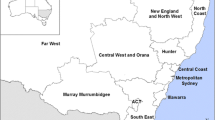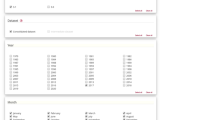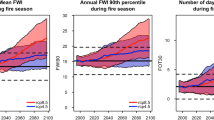Abstract
Fire danger indices are descriptors of fire potential in a large area, and combine a few variables that affect the initiation, spread and control of forest fires. The Canadian Fire Weather Index (FWI) is one of the most widely used fire danger indices in the world, and it is built upon instantaneous values of temperature, relative humidity and wind velocity at noon, together with 24 hourly accumulated precipitation. However, the scarcity of appropriate data has motivated the use of daily mean values as surrogates of the instantaneous ones in several studies that aimed to assess the impact of global warming on fire. In this paper we test the sensitivity of FWI values to both instantaneous and daily mean values, analyzing their effect on mean seasonal fire danger (seasonal severity rating, SSR) and extreme fire danger conditions (90th percentile, FWI90, and FWI>30, FOT30), with a special focus on its influence in climate change impact studies. To this aim, we analyzed reanalysis and regional climate model (RCM) simulations, and compared the resulting instantaneous and daily mean versions both in the present climate and in a future scenario. In particular, we were interested in determining the effect of these datasets on the projected changes obtained for the mean and extreme seasonal fire danger conditions in future climate scenarios, as given by a RCM. Overall, our results warn against the use of daily mean data for the computation of present and future fire danger conditions. Daily mean data lead to systematic negative biases of fire danger calculations. Although the mean seasonal fire danger indices might be corrected to compensate for this bias, fire danger extremes (FWI90 and specially FOT30) cannot be reliably transformed to accommodate the spatial pattern and magnitude of their respective instantaneous versions, leading to inconsistent results when projected into the future. As a result, we advocate caution when using daily mean data and strongly recommend the application of the standard definition for its calculation as closely as possible. Threshold-dependent indices derived from FWI are not reliably represented by the daily mean version and thus can neither be applied for the estimation of future fire danger season length and severity, nor for the estimation of future extreme events.





Similar content being viewed by others
References
Andrews P, Loftsgaarden D, Bradshaw L (2003) Evaluation of fire danger rating indexes using logistic regression and percentile analysis. Int J Wildland Fire 12:213–226
Bedia J, Herrera S, Gutiérrez J, Zavala G, Urbieta I, Moreno J (2012) Sensitivity of Fire Weather Index to different reanalysis products in the Iberian Peninsula. Nat Hazards Earth Syst Sci 12:699–708. doi:10.5194/nhess-12-699-2012
Brands S, Gutiérrez J, Herrera S, Cofiño A (2012) On the use of reanalysis data for downscaling. J Clim 25:2517–2526. doi:10.1175/JCLI-D-11-00251.1
Brown T, Hall B, Westerling A (2004) The impact of twenty-first century climate change on wildland fire danger in the Westerns United States: an applications perspective. Clim Change 62:365–388
Camia A, Amatulli G, San Miguel-Ayanz J (2008) Past and future trends of forest fire danger in Europe. Tech. Rep. EUR 23427 EN—2008, Institute for Environment and Sustainability, Joint Research Centre, European Comission, Ispra, Italy
Carvalho A, Flannigan MD, Logan K, Miranda AI, Borrego C (2008) Fire activity in Portugal and its relationship to weather and the Canadian Fire Weather Index System. Int J Wildland Fire 17:328–338
Carvalho A, Flannigan MD, Logan KA, Gowman L, Miranda AI, Borrego C (2010) The impact of spatial resolution on area burned and fire occurrence projections in Portugal under climate change. Clim Change 98:177–197
Chandler C, Cheney P, Thomas P, Trabaud L, Williams D (1983) Fire in forestry. Forest fire behavior and effects, vol 1. Wiley, New York, USA
Christensen J, Carter T, Rummukainen M, Amanatidis G (2007) Evaluating the performance and utility of Regional Climate Models: the PRUDENCE project. Clim Change 81:1–6. doi:10.1007/s10584-006-9211-6
Costa L, Thonicke K, Poulter B, Badeck F (2011) Sensitivity of Portuguese forest fires to climatic, human, and landscape variables: subnational differences between fire drivers in extreme fire years and decadal averages. Reg Environ Change 11:543–551
de Groot W, Goldammer J, Keenan T, Brady M, Lynham T, Justice C, Csiszar I, O’Loughlin K (2006) Developing a global early warning system for wildland fire. For Ecol Manag 234:S10. doi:10.1016/j.foreco.2006.08.025
Dee DP, Uppala SM, Simmons AJ, Berrisford P, Poli P, Kobayashi S, Andrae U, Balmaseda MA, Balsamo G, Bauer P, Bechtold P, Beljaars ACM, van de Berg L, Bidlot J, Bormann N, Delsol C, Dragani R, Fuentes M, Geer AJ, Haimberger L, Healy SB, Hersbach H, Hólm EV, Isaksen L, Kållberg P, Köhler M, Matricardi M, McNally AP, Monge-Sanz BM, Morcrette J, Park B, Peubey C, de Rosnay P, Tavolato C, Thépaut JN, Vitart F (2011) The ERA-Interim reanalysis: configuration and performance of the data assimilation system. Quart J R Meteorol Soc 137:553–597
Dowdy A, Mills G, Finkele K, deGroot W (2010) Index sensitivity analysis applied to the Canadian Forest Fire Weather Index and the McArthur Forest Fire Danger Index. Meteorol Appl 17:298–312
Flannigan M, Harrington J (1988) A study of the relation of meteorological variables to monthly provincial area burned by wildfire in Canada 1953–80. J Appl Meteorol 27:441–452
Flannigan M, Logan K, Amiro B, Skinner W, Stocks B (2005) Future area burned in canada. Clim Change 72(1–2):1–16. doi:10.1007/s10584-005-5935-y
Fugioka FM, Gill A, Viegas DX, Wotton B (2009) Fire danger and fire behavior modeling systems in Australia, Europe, and North America. In: Bytnerowicz A, Arbaugh M, Riebau A, Andersen C (eds) Developments in environmental science. Elsevier B.V., The Netherlands
Giannakopoulos C, Le Sager P, Bindi M, Moriondo M, Kostopoulou E, Goodess C (2009) Climatic changes and associated impacts in the Mediterranean resulting from a 2 °C global warming. Glob Planet Change. doi:10.1016/j.gloplacha.2009.06.001
Good P, Moriondo M, Giannakopoulos C, Bindi M (2008) The meteorological conditions associated with extreme fire risk in Italy and greece: relevance to climate model studies. Int J Wildland Fire 17:155–165
Hennessy K, Lucas C, Nicholls N, Bathols J, Suppiah R, Ricketts J (2005) Climate change impacts on fire-weather in South-East Australia. Tech. rep., CSIRO Marine and Atmospheric Research and Bushfire CRC and Australian Bureau of Meteorology, Australia
Krawchuk M, Moritz MA, Parisien MA, van Dorn J, Hayhoe K (2009) Global Pyrogeography: the current and future distribution of wildfire. PLoS ONE 4:e5102. doi:10.1371/journal.pone.0005102
Littell J, McKenzie D, Peterson D, Westerling A (2009) Climate and wildfire area burned in Western U.S. ecoprovinces, 1916–2003. Ecol Appl 19:1003–1021
Moreno J, Zavala G, Martin M, Millán A (2010) Forest fire risk in spain under future climate change. In: Settele J, Penev L, Georgiev T, Grabaum R, Grobelnik V, Hammen V, Klotx S, Kotarac M, Kuehn I (eds) Atlas of biodiversity risks, Pensoft, Sofia & Moscow, pp 72–73
Moriondo M, Good P, Durao R, Bindi M, Giannakopoulos C, Corte-Real J (2006) Potential impact of climate change on fire risk in the mediterranean area. Clim Res 31:85–95
Nakićenović N (2000) Greenhouse gas emissions scenarios. Technol Forecast Soc Change 65:149–166. doi:10.1016/S0040-1625(00)00094-9
Palheiro P, Fernandes P, Cruz M (2006) A fire behaviour-based fire danger classification for maritime pine stands: comparison of two approaches. For Ecol Manag 234:S54
Pechony O, Shindell DT (2010) Driving forces of global wildfires over the past millennium and the forthcoming century. P Natl Acad Sci USA 107(45):19,167–19,170. doi:10.1073/pnas.1003669107
Räisänen J (2007) How reliable are climate models? Tellus A 59:2–29
Roeckner E (2007) ENSEMBLES ECHAM5-MPI-OM 20C3M run2, monthly mean values. World Data Center for Climate. CERA-DB “ENSEMBLES_MPEH5_20C3M_2_MM”. Available at http://cera-www.dkrz.de/WDCC/ui/Compact.jsp?acronym=ENSEMBLES_MPEH5_20C3M_2_MM. Accessed Jan 2012
Rothermel R (1972) A mathematical model for predicting fire spread in wildland fuels. Research Paper INT-115, USDA Forest Service, Intermountain Forest and Range Experiment Station, p 40
Seneviratne S, Nicholls N, Easterling D, Goodess C, Kanae S, Kossin J, Luo Y, Marengo J, McInnes K, Rahimi M, Reichstein M, Sorteberg A, Vera C, Zhang X (2012) Changes in climate extremes and their impacts on the natural physical environment. In: Field C, Barros V, Stocker T, Qin D, Dokken D, Ebi K, Mastrandrea M, Mach K, Plattner GK, Allen S, Tignor M, Midgley P (eds) Managing the risks of extreme events and disasters to advance climate change adaptation. Cambridge University Press, Cambridge, UK, and New York, USA, pp 109–230
Skamarock W, Klemp J, Dudhia J, Gill D, Barker D, Duda M, Huang XY, Wang W, Powers J (2008) A description of the advanced research WRF Version 3. NCAR Technical Note 475, NCAR, Boulder, CO, USA
Sterl A (2004) On the (in)homogeneity of reanalysis products. J Clim 17(19):3866–3873
Stocks B, Fosberg M, Lynham T, Mearns L, Wotton B, Yang Q, Jin JZ, Lawrence K, Hartley G, Mason J, McKenney D (1998) Climate change and forest fire potential in Russian and Canadian boreal forests. Clim Change 38:1–13
Strauss D, Bednar L, Mees R (1989) Do one percent of the forest fires cause ninety-nine percent of the damage? For Sci 35:319–328
van der Linden P, Mitchell J (2009) ENSEMBLES: climate change and its impacts: summary of research and results from the ENSEMBLES project. Tech. rep., Met Office Hadley Centre, Exeter, UK
van Wagner CE (1987) Development and structure of the Canadian forest Fire Weather Index. Forestry Tech. Rep. 35, Canadian Forestry Service, Ottawa, Canada
van Wagner CE, Pickett TL (1985) Equations and FORTRAN program for the Canadian forest fire weather index system. Forestry Tech. Rep. 33, Canadian Forestry Service, Ottawa, Canada
Vázquez A, Moreno J (1993) Sensitivity of fire occurrence to meteorological variables in Mediterranean and Atlantic areas of Spain. Landsc Urban Plan 24:129–142
Vázquez A, Moreno J (1995) Patterns of fire occurrence across a climatic gradient and its relationship to meteorological variables in Spain. In: Moreno J, Oechel W (eds) Global change and Mediterranean–type ecosystems, ecological studies, vol 117. Springer, New York, USA
Wotton B, Alexander M, Taylor S (2009) Updates and revisions to the 1992 Canadian forest fire behavior prediction system. Information Report GLC-X-10, Natural Resources Canada, Canadian Forest Service, Great Lakes Forestry Centre, Sault Ste. Marie, Ontario, Canada
Wotton BM (2009) Interpreting and using outputs from the Canadian Forest Fire Danger Rating System in research applications. Environ Ecol Stat 16:107–131. doi:10.1007/s10651-007-0084-2
Zahn M, von Storch H (2010) Decreased frequency of North Atlantic polar lows associated with future climate warming. Nature 467:309–312
Acknowledgements
The research leading to these results has received funding from the European Union’s Seventh Framework Programme (FP7/2007–2013) under grant agreement 243888 (FUME Project). J.F. acknowledges financial support from the Spanish R&D&I programme through grant CGL2010-22158-C02 (CORWES project).
The ESCENA project (200800050084265) of the Spanish “Strategic action on energy and climate change” provided the WRF RCM simulation used in this study. We acknowledge three anonymous referees for their useful comments that helped to improve the original manuscript.
Author information
Authors and Affiliations
Corresponding author
Rights and permissions
About this article
Cite this article
Herrera, S., Bedia, J., Gutiérrez, J.M. et al. On the projection of future fire danger conditions with various instantaneous/mean-daily data sources. Climatic Change 118, 827–840 (2013). https://doi.org/10.1007/s10584-012-0667-2
Received:
Accepted:
Published:
Issue Date:
DOI: https://doi.org/10.1007/s10584-012-0667-2




